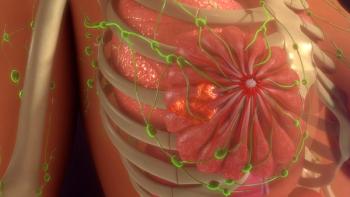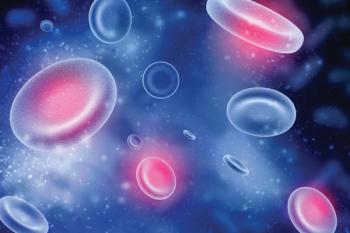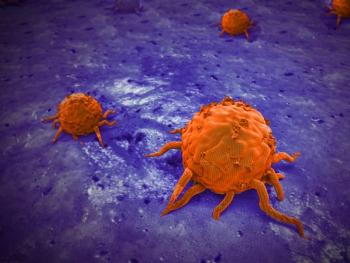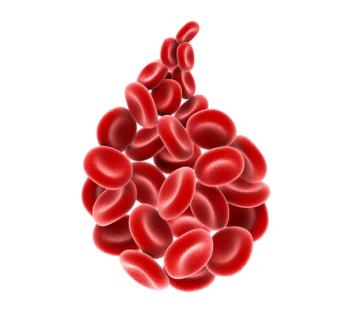
PFS, OS Improve With Cilta-Cel in R/R Multiple Myeloma Subgroups
Subgroup data from CARTITUDE-4 suggest that cilta-cel may overcome the poor prognosis associated with some high-risk features in multiple myeloma.
Progression-free survival (PFS) and overall survival (OS) improved among subgroups of patients with relapsed/refractory multiple myeloma who received ciltacabtagene autoleucel (cilta-cel; Carvykti), according to subgroup analysis findings from the phase 3 CARTITUDE-4 study (NCT04181827) presented in a poster session at the
Data showed that in those with high-risk cytogenetics—defined as del(17p), t(4;14), t(14;16), or gain/amp(1q) via fluorescence in situ hybridization—the CAR T-cell therapy (n = 123) led to a median PFS of 37.1 months (95% CI, 26.7-not evaluable [NE]) vs 10.3 months (95% CI, 7.6-12.6) with SOC (n = 132); the median OS in the respective arms was not reached (NR; 95% CI, NE-NE) and 38.0 months (95% CI, 34.0-NE). In those with standard-risk cytogenetics, cilta-cel (n = 69) led to a median PFS that was NR (95% CI, NE-NE) and a median OS that was also NR (95% CI, NE-NE); SOC (n = 70) led to a median PFS of 20.6 months (95% CI, 11.2-33.6) and a median OS that was NR (95% CI, 34.7-NE).
Within the group of patients with EMD, those who received cilta-cel (n = 21) experienced a median PFS of 12.6 months (95% CI, 1.2-18.4) vs 4.0 months (95% CI, 2.8-8.4) with SOC (n = 18); the median OS was NR (95% CI, 3.8-NE) with the CAR T-cell therapy vs 15.7 months (95% CI, 8.8-NE) with SOC. In patients without EMD, those given cilta-cel (n = 187) experienced a median PFS that was NR (95% CI, 37.1-NE) vs 12.2 months (95% CI, 10.3-14.8) with SOC (n = 193); the median OS in the respective arms was NR (95% CI, NE-NE) and NR (95% CI, 37.8-NE).
A significant improvement in PFS and OS was observed with cilta-cel over SOC in each subgroup of prior line of therapy. In those who only received 1 prior line, cilta-cel (n = 68) led to a median OS that was NR (95% CI, 27.8-NE) vs 17.4 months (95% CI, 11.1-26.7) with SOC (n = 68); the median OS with the respective treatments was NR (95% CI, NE-NE) and NR (95% CI, 37.8-NE). In those who received 2 prior lines of therapy, the median PFS with cilta-cel (n = 83) was NR (95% CI, 25.9-NE) vs 12.2 months (95% CI, 7.5-14.0) with SOC (n = 87); the median OS with the respective approaches was NR (95% CI, NE-NE) and NR (95% CI, NE-NE). In those who received 3 prior lines, the median PFS with cilta-cel (n = 57) was also NR (95% CI, 29.1-NE) vs 7.6 months (95% CI, 3.8-10.7) with SOC (n = 56); the median OS in the respective arms was NR (95% CI, NE-NE) and 34.0 months (95% CI, 19.9-NE).
“These data continue to support a positive benefit-risk ratio for cilta-cel in patients with lenalidomide [Revlimid]-refractory multiple myeloma as early as after first relapse,” Surbhi Sidana, MD, of Stanford University School of Medicine, in Stanford, California, and colleagues, wrote in the poster.
Catching Up on CARTITUDE-4
The open-label trial enrolled patients with relapsed/refractory multiple myeloma whose tumors were resistant to lenalidomide and who had received 1 to 3 prior lines of therapy, including a proteasome inhibitor and an immunomodulatory drug.2 Patients had an ECOG performance status no higher than 1, and had not received prior CAR T-cell therapy or BCMA-targeted therapy.
Participants were randomly assigned 1:1 to receive SOC (n = 211), which was physician’s choice of pomalidomide (Pomalyst), bortezomib (Velcade), and dexamethasone (PVd) or daratumumab (Darzalex), pomalidomide, and dexamethasone (DPd), or a single infusion of cilta-cel post-physician’s choice of bridging therapy with PVd or DPd (n = 208). They were stratified by bridging therapy selection (PVd vs DPd), severity of disease at screening (I vs II vs III), and number of prior therapies received (1 vs 2 vs 3).
At a median follow-up of 15.9 months (range, 0.1-27.3), prior data from the study showed that the median PFS with cilta-cel was NR vs 11.8 months (95% CI, 9.7-13.8) with SOC (HR, 0.26; 95% CI, 0.18-0.38; P < .001). These data supported the
At a median follow-up of 33.6 months (range, 0.1-45.0), the hazard ratios for PFS and OS were 0.29 (95% CI, 0.22-0.39; P < .0001) and 0.55 (95% CI, 0.39-0.79; P = .0009), respectively, demonstrating a significant improvement with cilta-cel vs SOC.4 Moreover, the CAR T-cell therapy led to a higher overall minimal residual disease (MRD)–negative complete response or better (≥CR) rate vs SOC, at 82.1% vs 25.2%, and a higher sustained MRD-negative ≥CR rate vs SOC, at 51.7% vs 9.7%.5
Additional Subgroup Data
Within those who had high-risk cytogenetics, those with del(17p) who received cilta-cel (n = 49) experienced a median PFS of 29.9 months (95% CI, 13.4-NE) vs 8.7 months (95% CI, 5.1-14.0) with SOC (n = 43); the median OS with the respective treatments was NR (95% CI, NE-NE) and NR (95% CI, 17.3-NE).1 In those with t(4;14), cilta-cel (n = 30) led to a median PFS of 37.1 months (95% CI, 18.0-NE) vs 6.7 months (95% CI, 3.8-13.7) with SOC (n = 30); the median OS with the respective approaches was NR (95% CI, NE-NE) and 26.8 months (95% CI, 20.3-NE).
Moreover, in those with gain/amp(1q), the median PFS with cilta-cel (n = 89) was 37.1 months (95% CI, 25.9-NE) vs 10.3 months (95% CI, 7.5-14.0) with SOC (n = 107); the median OS with cilta-cel was NR (95% CI, NE-NE) vs 38.0 months (95% CI, 34.0-NE) with SOC. Lastly, in those with at least 2 cytogenetic abnormalities who received cilta-cel (n = 43), the median PFS was 29.8 months (95% CI, 10.8-NE) and the median OS was NR (95% CI, 29.8-NE); with SOC (n = 49), the median PFS was 6.7 months (95% CI, 4.7-10.3) and the median OS was 23.0 months (95% CI, 17.3-NE).
“Compared with SOC, cilta-cel improved PFS and OS in patients with high-risk cytogenetics, suggesting it may overcome the poor prognosis associated with these high-risk features,” Sidana said.
Disclosures: Sidana disclosed serving in a consultant or advisory role for AbbVie, BiolineRx, BMS/Celgene, Genentech/Roche, Johnson & Johnson, Kite, Legened Biotech, Pfizer, Regeneron, and Sanofi. Institutional research funding has been received by AbbVie, Allogene Therapeutics, BMS/Celgene, Johnson & Johnson, Magenta Therapeutics, and Novartis.
References
- Sidana S, Martínez-López J, Khan AM, et al. Ciltacabtagene autoleucel (cilta-cel) vs standard of care (SOC) in patients (pts) with relapsed/refractory multiple myeloma (MM): CARTITUDE-4 survival subgroup analyses. J Clin Oncol. 2025;43(suppl 16):7539. doi:10.1200/JCO.2025.43.16_suppl.7539
- San-Miguel J, Dhakal B, Yong K, et al. Cilta-cel or standard of care in lenalidomide-refractory multiple myeloma. N Engl J Med. 2023;389(4):335-347. doi:10.1056/NEJMoa2303379
- Carvykti is the first and only BCMA-targeted treatment approved by the US FDA for patients with relapsed or refractory multiple myeloma who have received at lease one prior line of therapy. News release. Johnson & Johnson. April 5, 2024. Accessed June 1, 2025. https://www.jnj.com/media-center/press-releases/carvykti-is-the-first-and-only-bcma-targeted-treatment-approved-by-the-u-s-fda-for-patients-with-relapsed-or-refractory-multiple-myeloma-who-have-received-at-least-one-prior-line-of-therapy
- Mateos M-V, San-Miguel J, Dhakal, et al. Overall survival (OS) with ciltacabtagene autoleucel (cilta-cel) versus standard of care (SoC) in lenalidomide (len)-refractory multiple myeloma (MM): phase 3 CARTITUDE-4 study update. Presented at: 2024 International Myeloma Society Annual Meeting; September 25-28, 2024; Rio de Janeiro, Brazil. Abstract OA – 65.
- Popat R, Oriol A, Cavo M, et al. Ciltacabtagene autoleucel (cilta-cel) vs standard of care (SOC) in patients with lenalidomide (len)-refractory multiple myeloma (MM) after 1-3 lines of therapy: minimal residual disease (MRD) negativity in the phase 3 Cartitude-4 trial. Blood. 2024;144(suppl 1):1032. doi:10.1182/blood-2024-201533
Newsletter
Stay up to date on recent advances in the multidisciplinary approach to cancer.



















































































